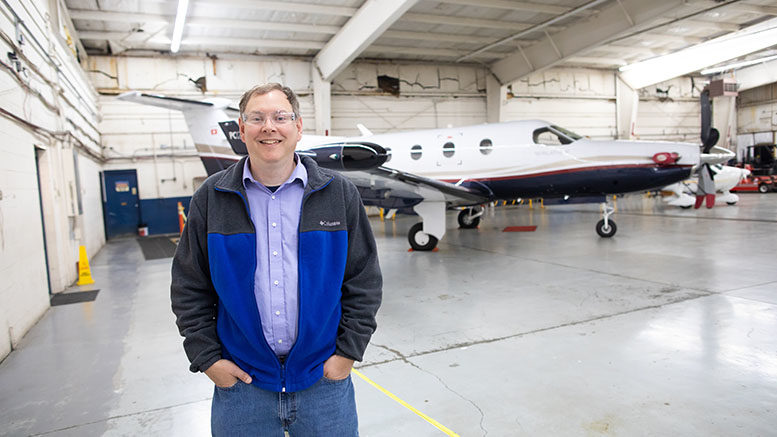Mark Haberbusch has always been a dreamer. And his biggest dream is finally taking flight.
Nearly three decades ago, the Case Western Reserve University graduate, who studied fluid and thermal engineering science and designed high-altitude aircraft, had an idea. Haberbusch was cutting his grass at his home in Amherst, Ohio, when he stopped and looked up.
“I thought it would be great to use liquid hydrogen to power small aircrafts and fly out of the Lorain County Regional Airport,” he recalls. “I hoped one day I could do that.”
Today, the entrepreneur is making that dream a reality with the help of local business support organizations, including Lorain County Community College (LCCC). In 2015, he founded NEOEx, a company combining fuel cell technology and liquid hydrogen to power unmanned aircrafts. He had been working on the technology since that day in his yard and thought the time was right.
“It had always been in the back of my mind, but the opportunity never really presented itself until drones became more and more popular,” Haberbusch says.
On battery power, small drones can typically fly for 60 minutes before needing to recharge, making them less than ideal for commercial applications. But Haberbusch knew he could achieve longer flight times with a different power source.
“We could power them with commercial fuel cells, which had started to become more readily available in the marketplace,” he says. “We could combine fuel cells with liquid hydrogen technology and apply it to these aircrafts.”
Landing his first customer
One year after launching the business, Haberbusch came to LCCC’s Great Lakes Innovation and Development Enterprise (GLIDE) for guidance. GLIDE helps Northeast Ohio entrepreneurs wrap sound business practices around great business ideas. It also runs the Innovation Fund, a pre-seed fund started by the LCCC Foundation that supports local startups to grow the region’s economy and foster job creation.
“GLIDE and the Innovation Fund allowed me to get the prototype started before the customer funding arrived,” Haberbusch says. “I could keep schedule through this critical initial phase.”
Staying on that schedule helped Haberbusch score his first customer – the National Oceanic and Atmospheric Administration (NOAA) – and land his first federal contract. NOAA’s National Weather Service awarded Haberbusch a Small Business Innovation Research grant in 2016 to prove his fuel cell-powered flights worked. The National Weather Service wanted to attach sensors to the aircraft to collect data that would help them produce more accurate forecasts and issue more timely weather warnings.
“They wanted to fly out in front of the hurricane and collect data because that’s really what impacts the models,” Haberbusch says. “That helps them determine which way the hurricane is going to go and improves the models.”
With NOAA as his customer, Haberbusch conducted hydrogen fuel cell-powered flight testing in an aircraft weighing less than 55 pounds, carrying the weather-sensing payload. The successful demonstration helped open the door to other potential customers and applications.
“Customers are very interested in staying in the air for a long period of time,” he says. “They want to do things like package delivery or maybe monitor rip currents.”
Ready to refuel
Another interest potential customers have had, is in the liquid hydrogen that fuels the aircraft. More specifically, where it’s produced and how involved the refueling process is. To answer that question, Haberbusch is working with his second big customer – the U.S. Air Force.
After proving the need for his technology with the U.S. Air Force with a Phase I Small Business Technology Transfer award, Haberbusch is using a $750,000 Phase II award to demonstrate the technology’s refueling capabilities.
“We found a huge gap that the U.S. Air Force identified related to energy distribution,” Haberbusch says. “Now we’re looking forward to the Phase II to do that demonstration and show how we can not only make the fuel locally, but we can actually fly these kinds of missions they are looking for.”
To help him complete the demonstration, Haberbusch hired three Ohio college interns, including an LCCC student, who received work-based learning credit for their time. Haberbusch says he’s starting small – testing the refueling system on aircraft that hold less than a gallon of liquid hydrogen – and then scaling.
“The idea is to be able to take this refueling technology and bring it towards larger aircraft so we can scale the size of the tank size and scale the aircraft,” he says.
But as Haberbusch knows, even the biggest dreams must start somewhere. A visit to the Wright Brothers National Memorial in North Carolina confirmed that thought.
“When you look at how far they flew in those first couple of flights you think, that’s not very far,” he says. “But it was so important to take that first flight. We want to be pioneers when it comes to flying with liquid hydrogen.”

